Your cart is empty
WRITING BY Aaron Gulley PHOTOS BY Jen Judge
LONG FORM: 3800 words
SIBERIA | 70.6598° N, 69.9045° E
Smoke rises in twisted cords from a row of tepees on a snowy knoll. At the clatter of our approaching snowmobiles, several women wound in thick furs emerge into the last indigo smolder of the Arctic evening. When we stop and alight, they whisper to one another in a language I’ve never heard. Children flitter in the shadows and point to us as if we’re ghosts.

In winter it’s always cold and dark,” said Sahsa, the moon-faced nenets, who was transporting us. “If we waited for light and warmth, we’d be three months behind the reindeer.
The Nenets, a tribe of nomadic reindeer herders who migrate seasonally across the Siberian tundra, have been living in this icy wilderness of northwest Russia for at least a millennium. Yet I’m here with only the second group of Westerners to ever visit this band of six families. Officially known as Brigade 20 — a relic of Soviet-era collectivization — this group travels some 600 miles down the Yamal Peninsula and back each year in the constant pursuit of forage for its animals. We’ve caught up with them near their southernmost range, but before the spring melt they must traverse the frozen waters of the Gulf of Ob, a 30-mile-wide ice sheet that separates their winter and summer grounds. Our goal is to make the crossing with them.
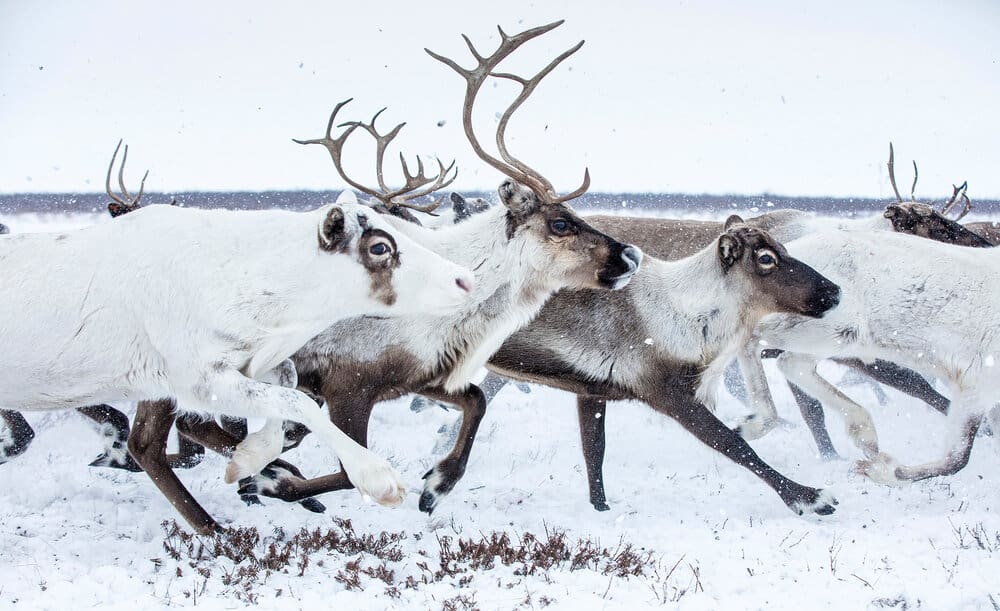
Siberia in winter might seem as appealing as, say, Death Valley in summer or Antarctica, well, anytime. Places of such climatic and geographic extremes are usually the realm of explorers, scientists, exiled dissidents, and native peoples who are shrewd and hardy enough to inhabit them. But the emptiness of the Siberian tundra, remote and removed from the comforts and distractions of modern life, is exactly what drew me. In the same way that I walk into the woods during hunting season to press pause on the constancy of our always-on world, I hope that winter in Siberia, one of the planet’s wildest and most sparsely populated expanses, will provide a backcountry escape writ large.
“This sort of experience is about stripping things back to the essentials,” says Secret Compass founder Tom Bodkin, whose British travel company has organized this 10-day expedition. Siberia, like Secret Compass’s other off-grid destinations, is an immersion into a simpler existence. “Have you got shelter? How and when are you going to eat? Where will you sleep?”
I wrestled with these elemental questions throughout day one. Because of packing, we didn’t leave town for Brigade 20’s camp until 4 p.m. With darkness closing in and temperatures sliding below 0°F, all my backcountry instincts screamed to me that it was reckless to set out across 75 miles of frozen tundra. “In winter, it’s always cold and dark,” said Sasha, the moon-faced Nenets who was transporting us. “If we waited for light and warmth, we’d be three months behind the reindeer.” So we loaded up in snowmobile-drawn sledges — refrigerator-sized plywood boxes on wooden runners — and smashed into open country. That was when all the precariousness of the situation hit me; I had no idea where we were going and no gear or provisions of my own. It was the antithesis of my mantra back home of absolute self-reliance, but here I was, a guest in an alien land. Without the Nenets, I’d likely die of exposure within hours. When the reindeer-hide teepees, which the Nenets call chum, appeared on the snowy knoll five hours after we’d set out, I breathed a deep exhalation of relief.
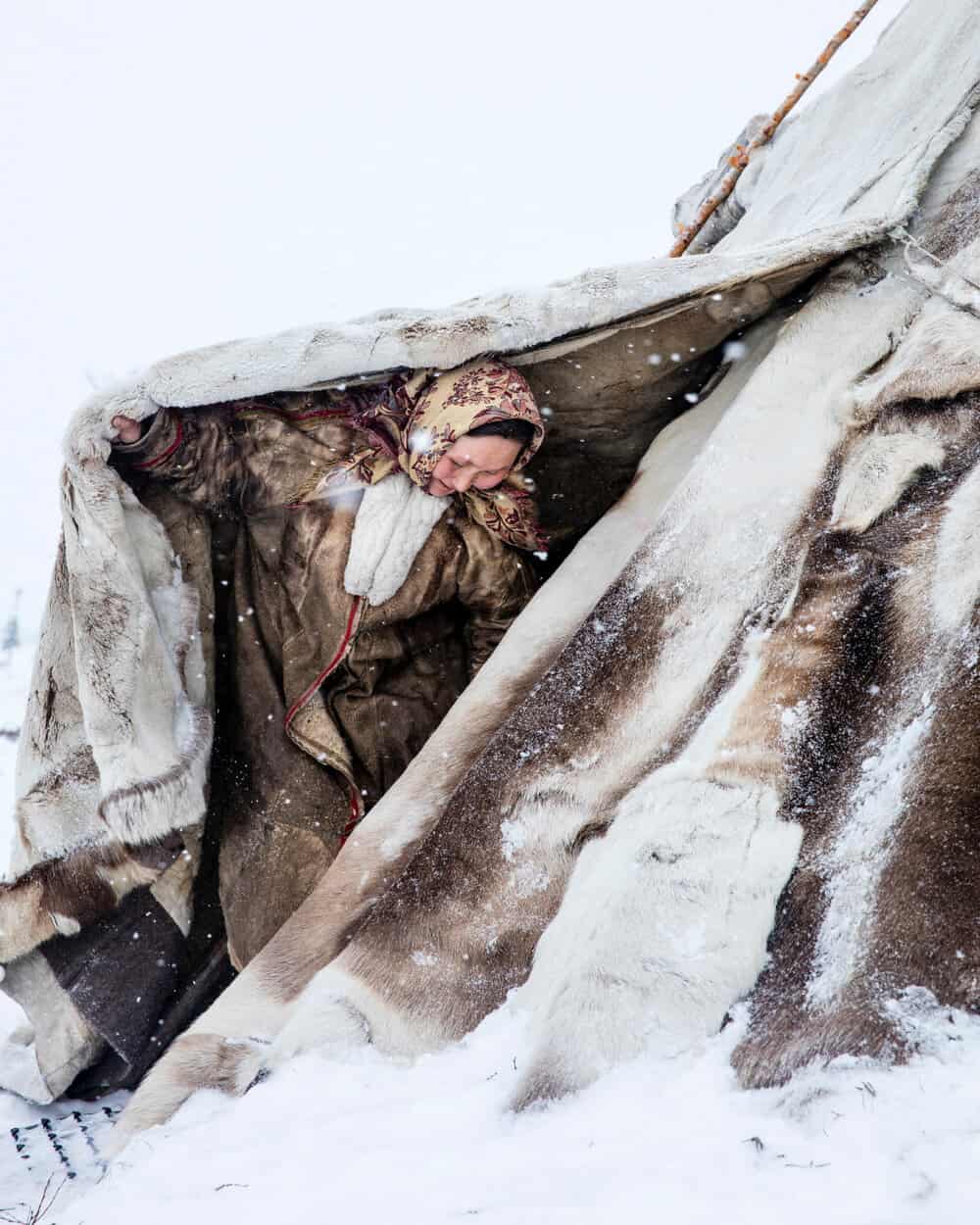
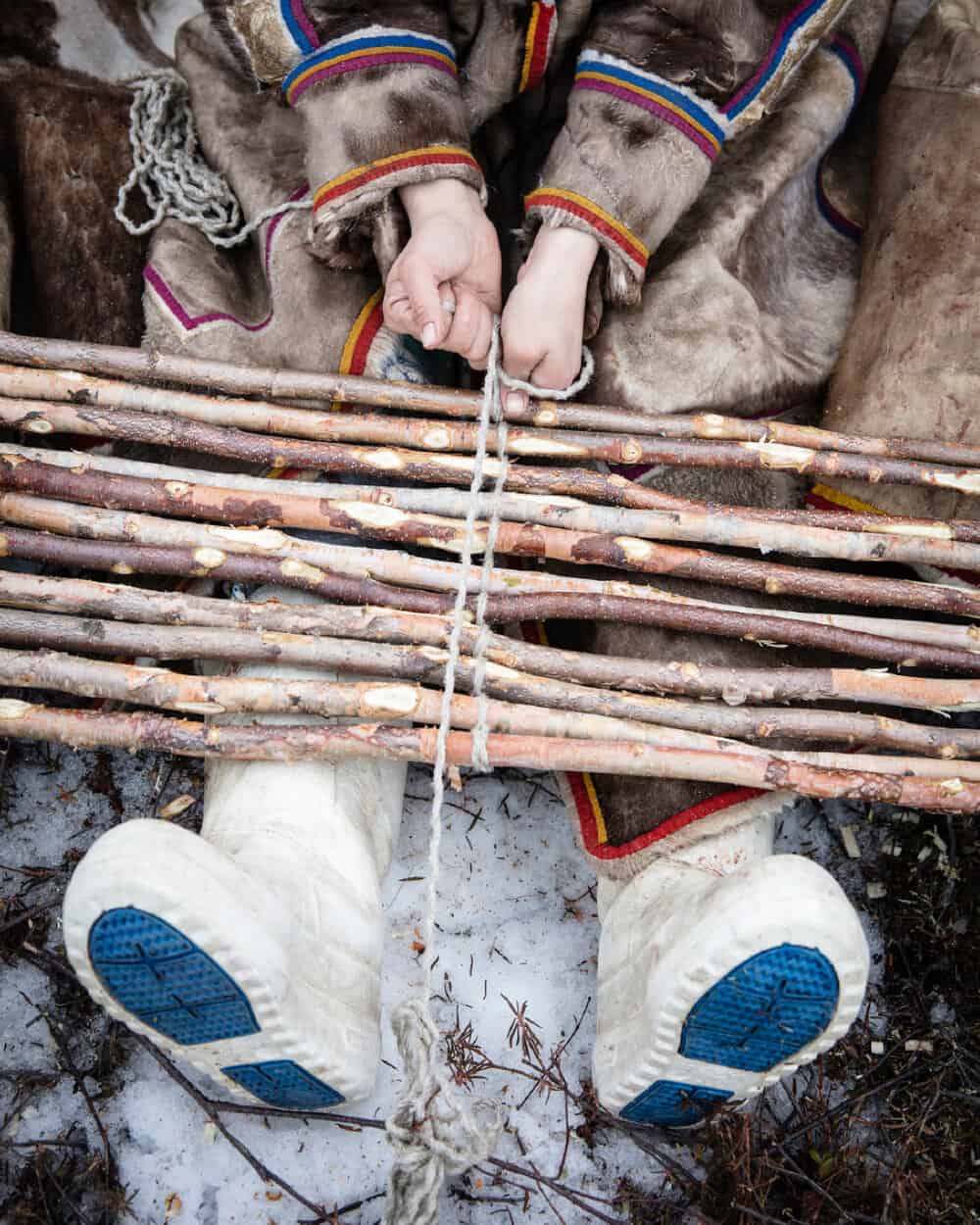
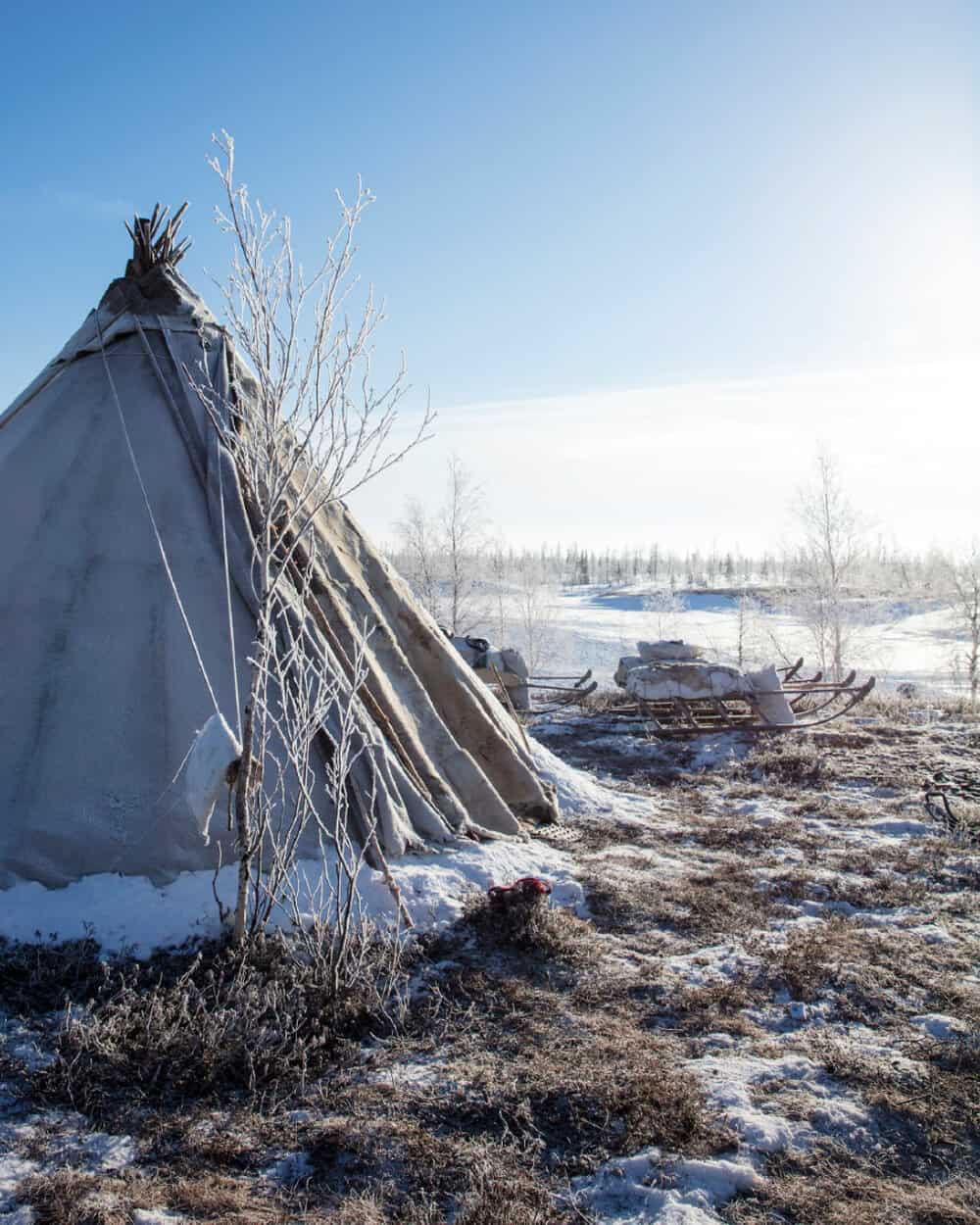
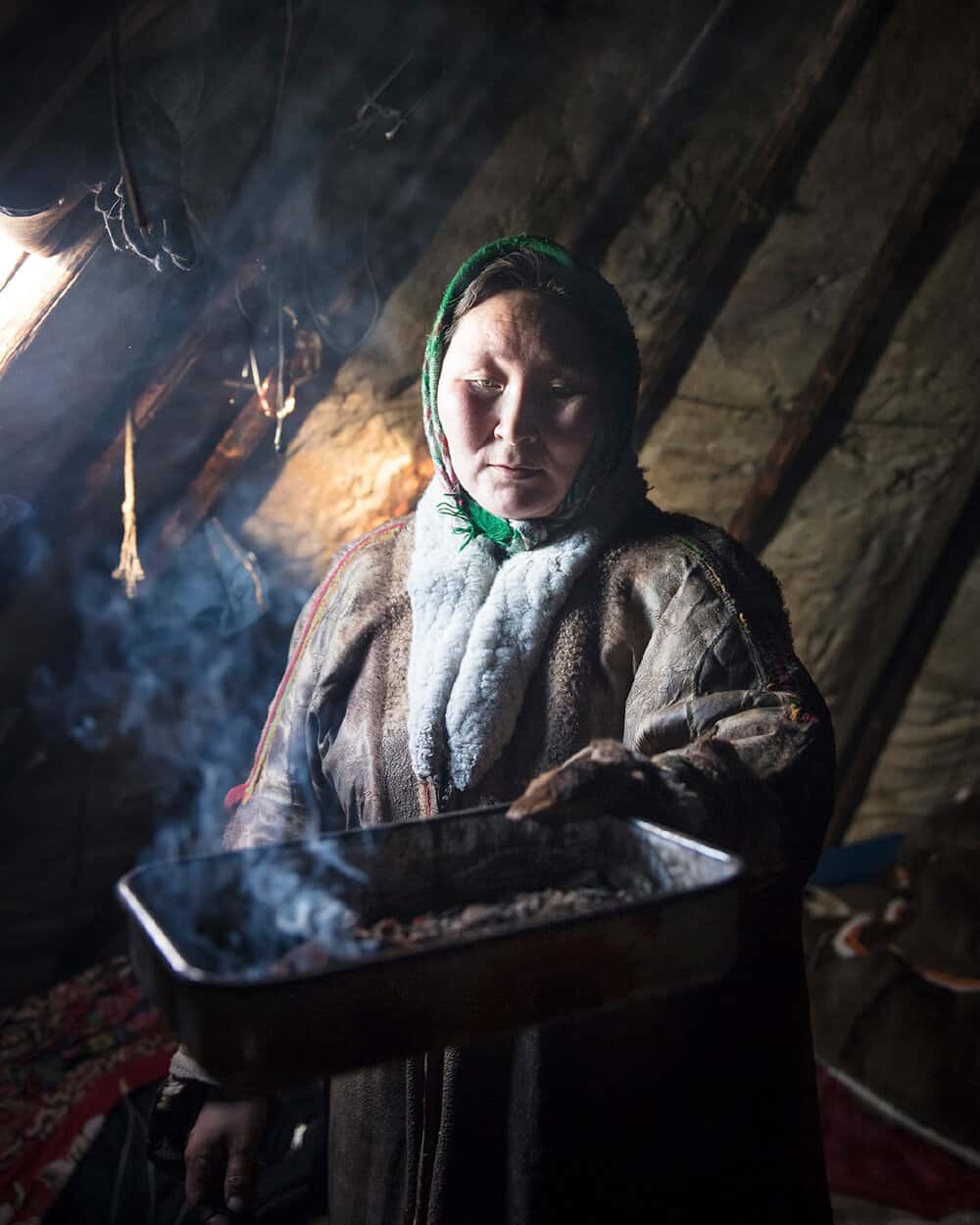
For the next 10 days, I’ll stave off the cold wearing my host family’s hand-sewn furs, eat what they eat — mostly uncooked reindeer and fish — and try to not get in the way. At night, we’ll lie shoulder-to-shoulder under shared furs like packed sardines. In the language of the Nenets, yamal translates as “edge of the world,” and from the moment we climb out of the sledges, that’s how it feels, as if I’ve tumbled over a precipice of time and credulity. Like most Nenets, whose worldwide population is estimated around 45,000 people, Brigade 20 is a family unit, in this case consisting of four brothers including Sasha, an uncle, a cousin, and all their clattering kin and chaos — 20 people in all living in five chum. Along with my wife, photographer Jen Judge, and our translator, Evgeniy or Zhenya (pronounced jen-yah), I’m assigned to chum five, the home of the cousin, Alexey Khudi; his wife, Rosa Yaptik; and their three-year-old daughter, Marianna. The couple’s three older children attend boarding school in Yar-Sale, the booming natural-gas town at the base of the Yamal Peninsula from which we traveled.
Rosa draws back the reindeer-hide door flap of the chumand disappears inside. Then she pops back out. She repeats this once, twice, three times, methodically pulling the flap over her shoulder as she pivots. Our first lesson in Nenet life is how to enter the tent without letting in the cold. But what’s really clear is that, out here, I’m as wide-eyed and helpless as an infant. From figuring out how to take care of hygiene issues discreetly while wearing 25 pounds of fur, to puzzling through arcane social rules — such as where you can and can’t put your feet inside the tent — everything is a bewilderment.
After we blunder through the front door, the frigid darkness gives way to ocher lamplight and a wood-fired stove. The chum, a fortress of fur as cozy as a kid’s fort but strong enough to withstand the hammer of Arctic winds, is a measure of wealth and stability on the tundra, and it will be the center of our world in Siberia. Built on a frame of 32 pine poles, the structure is sheathed in double layers of reindeer pelts stitched together with tendon thread. Inside, wooden planks support the kitchen goods, meltwater pot, and woodstove. Sitting and sleeping space is on the east and west, with willow-like switches topped by hand-woven grass mats and more reindeer furs. Rosa gestures for us to sit on the west side, then goes back to her chores, preparing a meal for when Alexey arrives and stitching a new pair of reindeer-hide slippers, or kysii. It feels standoffish, though we’ll come to understand that the Nenets are taciturn people. We will spend a lot of our visit sitting in the chum, staring at one another. “Why have you come here?” Rosa will ask me more than once during the trip. “Don’t you have work to do at home?”
This is a reasonable question. Life on the tundra is ceaseless work, and to shirk the most basic tasks for even a few hours, such as tending to the fire, could mean ruin. Alexey and Rosa make it clear they want us to help with chores. They don’t need our help, they just don’t know what else to do with us. Rosa shows me how to use what looks like a whaling harpoon to chip aquamarine ice slabs from a nearby pond and luge them on a small sled home for meltwater. Snow must be shoveled daily in drifts around the chumto buttress its walls and keep out wind. And Alexey leaves me piles of deadwood to split. I’m terrible at it, like the golfer who scrunches his eyes and swings too hard. Rosa shakes her head and shows me over and over how to aim the ax. I can’t get it right, but with daytime temperatures often well below zero and nowhere to go but the chum, I’m grateful for something to do outside that keeps me warm. Even if I chop wood poorly, I start to appreciate the meditative quality of the work. It’s the antithesis of my frenetic life back home.
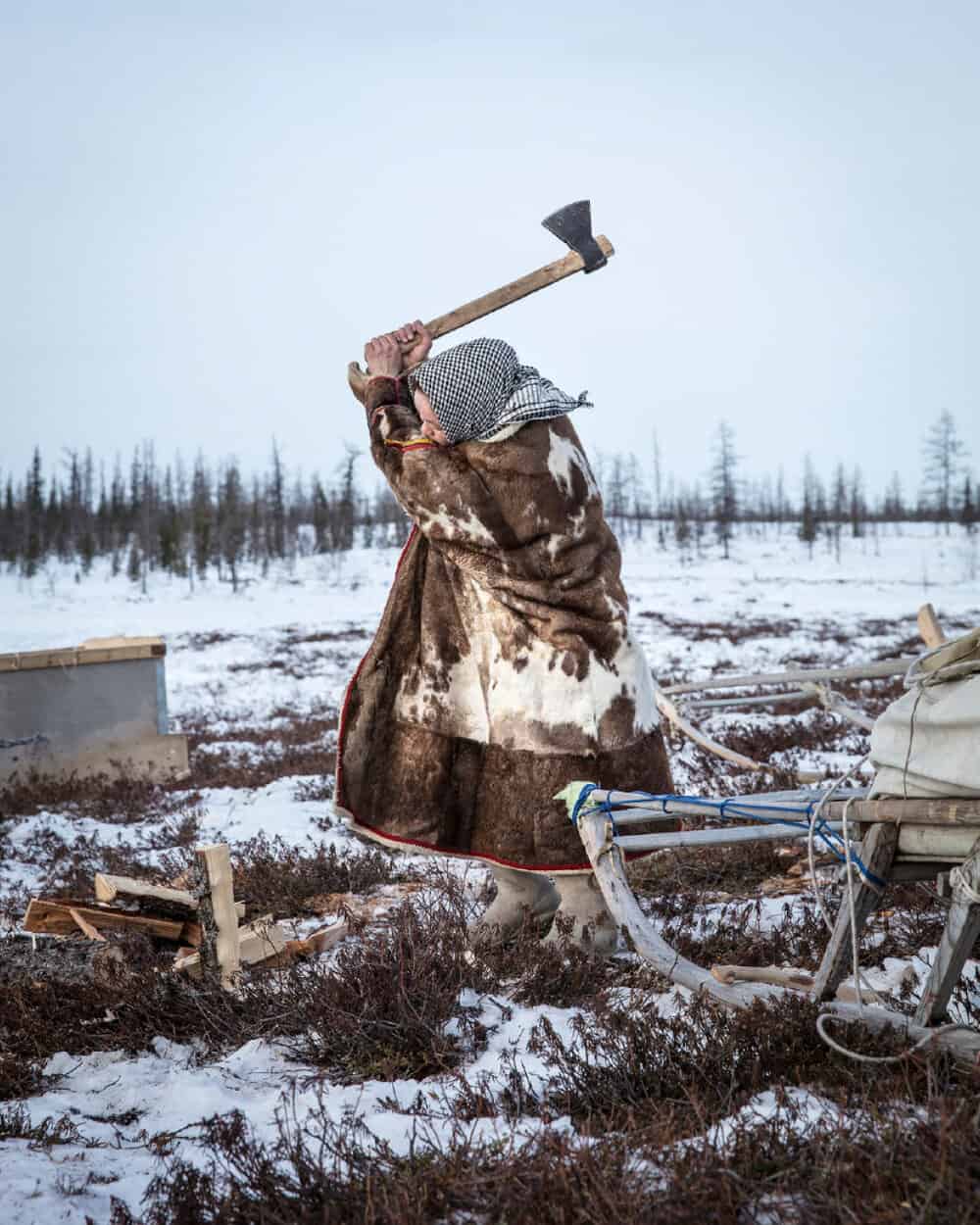
As the days go by, teatime is the only thing more frequent than chores. Nenets rarely eat full meals, instead sitting five or more times a day for small portions of whitefish — usually muksun or cisco — served in frozen hunks that you dice from the bone. If they are near water, they catch the fish; when they are inland, they trade meat and furs with travelers. Occasionally there’s reindeer, also served frozen or raw, as well as thick slices of crusty, processed bread, which you slather with butter and sprinkle with sugar. Then comes chai, black tea with sugar or sweetened condensed milk. Rosa shows us how to pour it from the demitasse into the saucer to cool, then slurp.
During these break times, we start to get to know our family. Overall, Nenets are about as gregarious as deadwood, and interactions between Rosa and Alexey are spare to none, though I occasionally catch them looking warmly at one another. The couple is also stern with three-year-old Marianna, who blunders around as clumsily as a baby seal in her puff of furs. It’s said that when Nenets children are very young, mothers tie them to a stick in the snow to keep them out of trouble. When the children eventually deduce how to free themselves (well before the age of three, judging by Marianna), they are considered old enough to take care of themselves and allowed to come and go from the chum as they please. That might sound harsh, but it teaches the independence and self-reliance that’s critical for surviving the Arctic.
While our hosts are mostly aloof with me and the other Secret Compass guests, they slowly thaw. One late morning, as we’re sucking up the last sips of the day’s second tea, Alexey looks at me and jokes, “You better get back to chopping. At your rate, you might not finish before dark.” It’s as if he’s freed me from my stick.
There’s debate over whether to call the Nenets herders or hunter-gatherers. While it’s true they direct their reindeer the way you might stack rocks to divert a river into a side channel, they mostly follow the animals’ natural migration and live off of them by selling meat in towns. At night, the men herd the deer into an untracked field or meadow; come morning, they return and follow the tracks. Nomenclature aside, what’s clear is that the Nenets are some of the planet’s last true nomads, on the move for all but a few of the darkest, coldest months of the year.
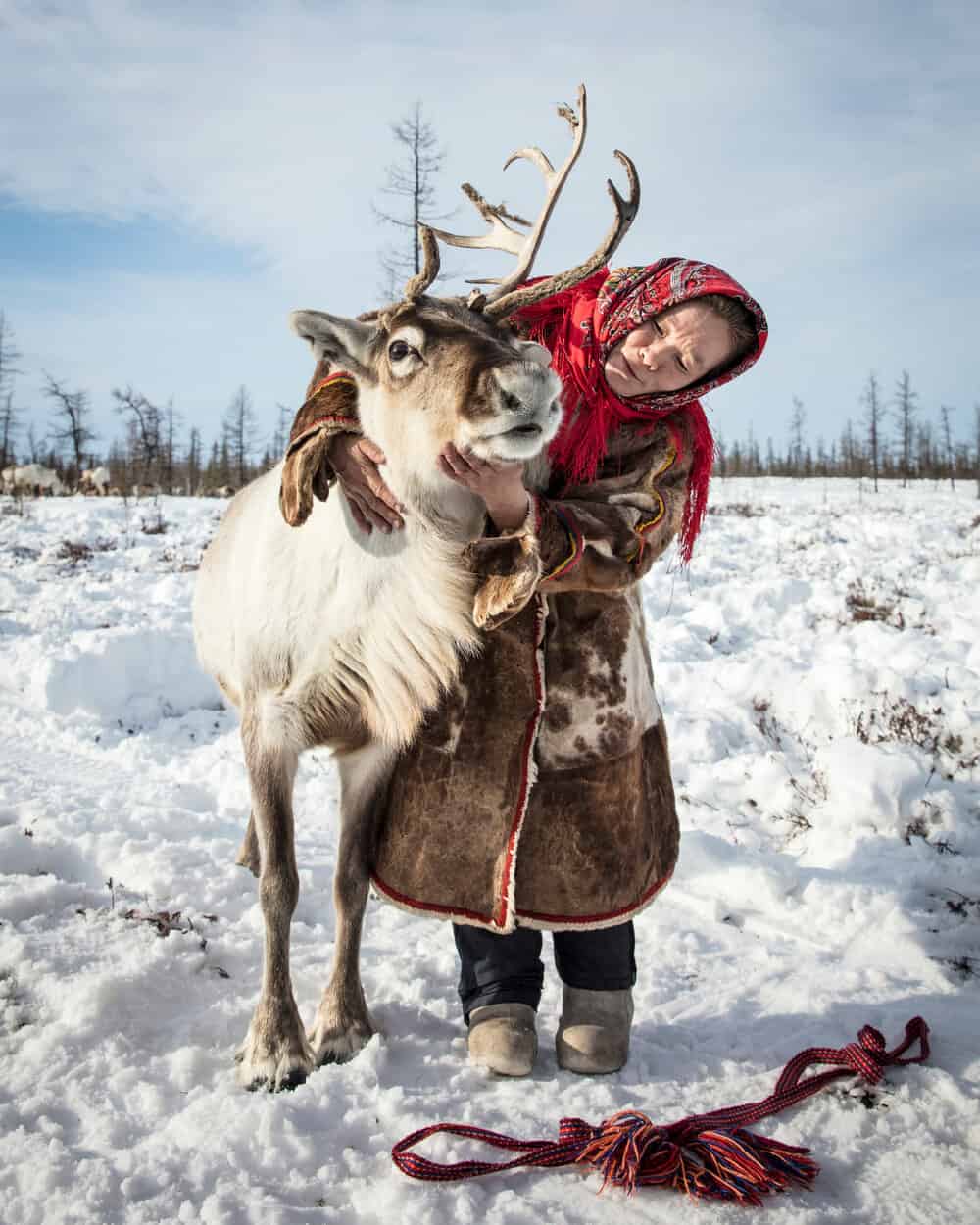
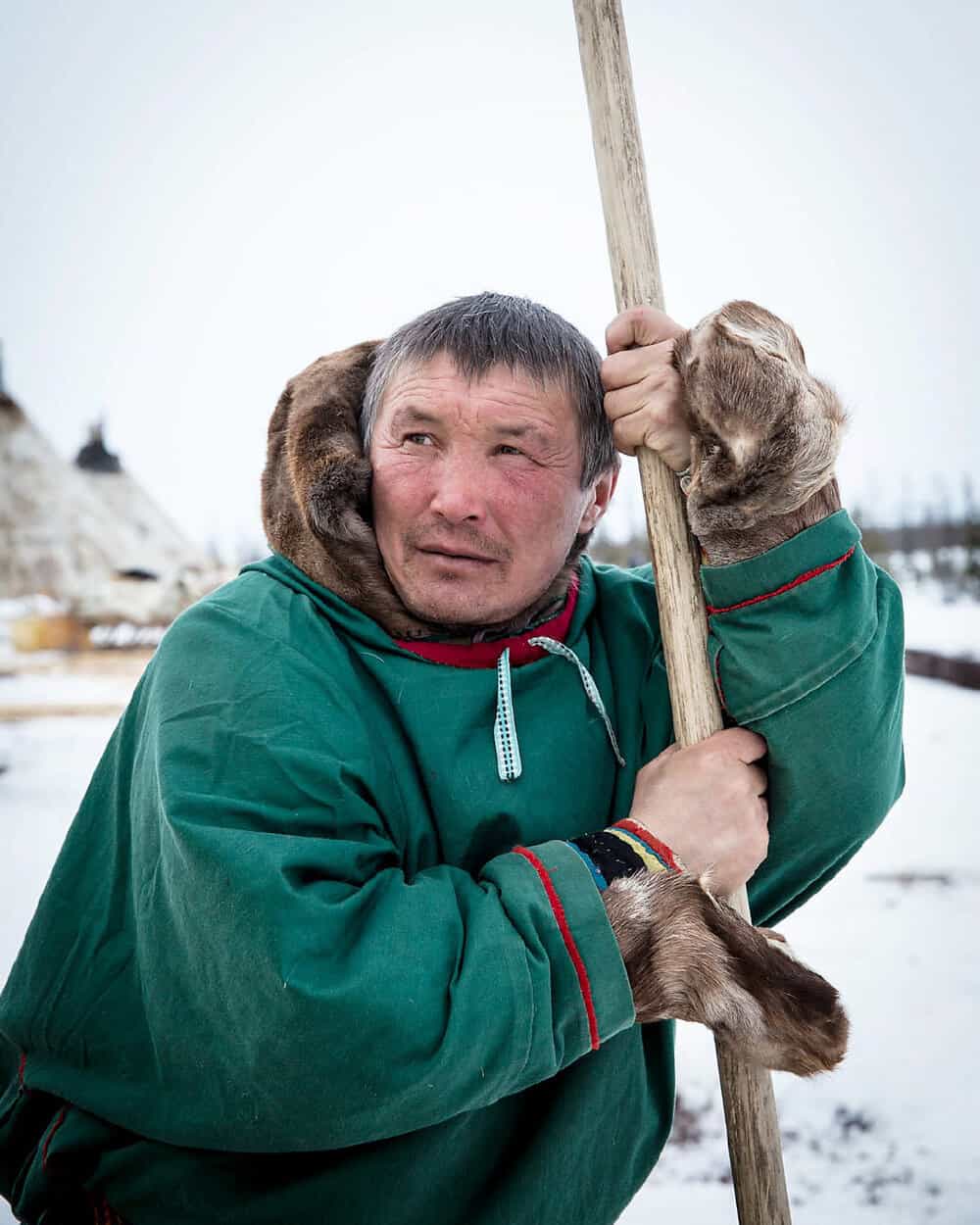
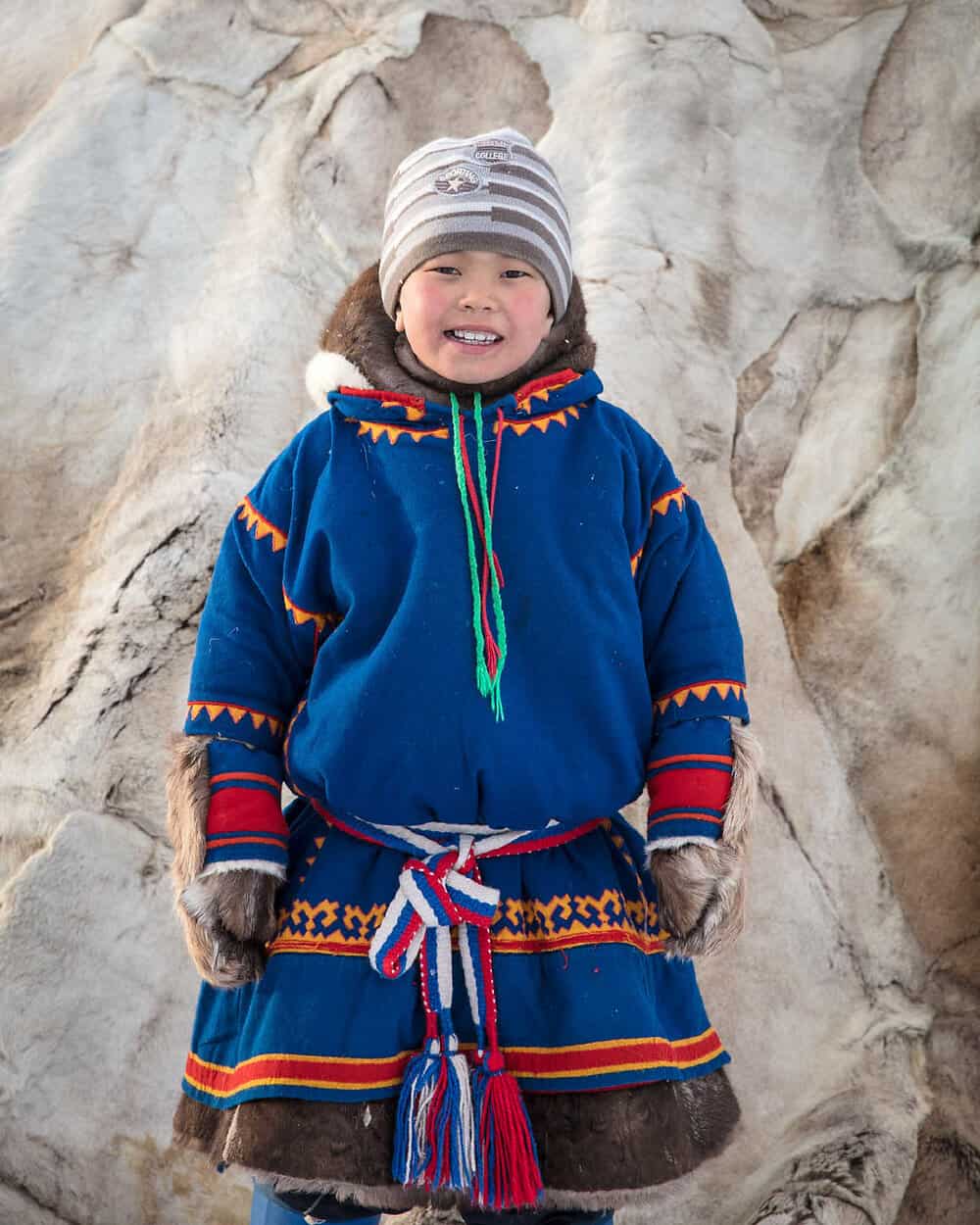
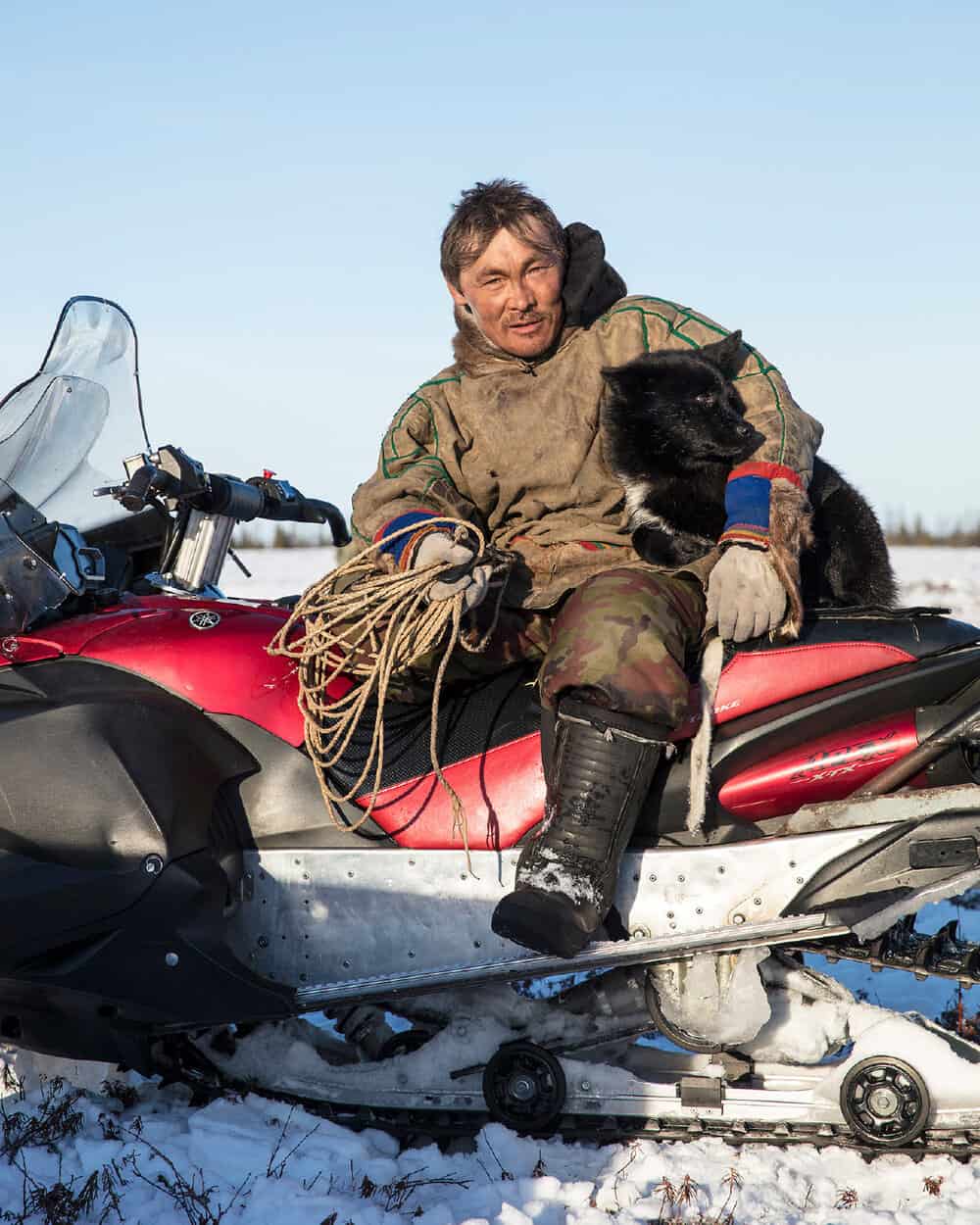
“Life on the tundra is ceaseless work. and to shirk the most basic tasks for even a few hours, such as tending the fire, could mean ruin. Alexey and Rosa make it clear that they want us to help with chores. They don’t need our help, they just don’t know what else to do with us. ”
A few days into our stay, Alexey must round up the reindeer for our first migration. He asks if Jen, Zhenya, and I want to come. When we agree, he hooks up a box sledge behind his snowmobile for us to ride in. The slate sky sputters snow and the wind chill is fierce, yet we’re snug in our voluminous Nenets furs: knee-length, hooded pullovers for men called malitsaand longer, lace-front versions for women called yagushka. Alexey says that in the old days, before snowmobiles made it easy to travel long distances between the camp and the herds, the men would sleep out on the wintry tundra with nothing but these furs for protection.
After half an hour, we come upon a herd of animals so large that it stretches to he horizon. It’s our first time seeing reindeer, which are smaller than mule deer and clumsy with broad antlers. They’re comical creatures, rooting in the snow with their snouts for lichen and lurching like Labrador puppies with too-big feet when they run. I ask how many there are, and Alexey says 2,500. Maybe 3,500. This ambiguity is common here. Set out on a four-mile trip, and 30 minutes later, at a rest break, five miles remain. Now, when I press Alexey, he says, after a pause, “I don’t think about silly details.” The vagueness frustrates my analytical side, but life here focuses on the immediate, the concrete. The deer must be tended, the tents collapsed and moved, the camp raised again.
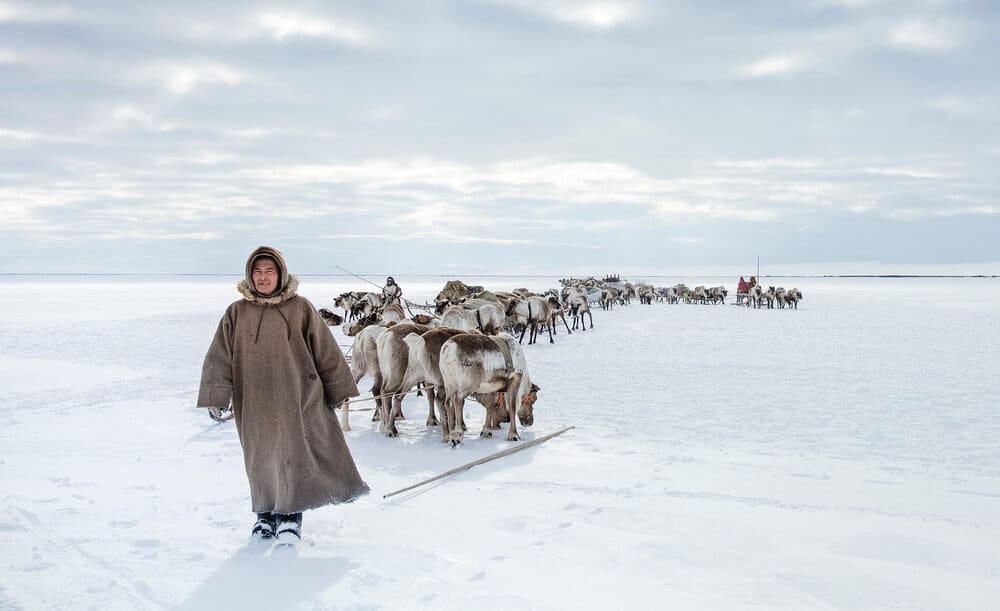
Surrounded by the herd, Alexey shows us his tyzyan, literally “reindeer catcher,” a deerskin leather rope he wove and uses to lasso animals. He stands on the seat of his snowmobile and cries out, “Tel yat!” After a few minutes, three or four reindeer emerge from the scrum. These are his pets, animals he and Rosa hand-reared in their tent after a nasty freeze a few years back. They come to his voice, and he feeds them bread. Next, he strides out into the herd and lassos a couple of herd bulls, then ties the animals to the sledge. When we set out again, a few reindeer follow the herd bulls, then a few more, until the entire drove is moving with us. We’re staging the animals closer to camp to facilitate our morning departure.At dawn, a blizzard has engulfed the camp. Clots of wet snow blast sideways, blotting out the chumto our west, just 20 yards away. There will be no migrating today; even reindeer-herding nomads take snow days. That doesn’t mean it’s a day off. When the snowfall ebbs in the afternoon, Alexey takes his snowmobile out and returns several hours later, pulling a tree he felled. It took so long, he explains, because he had to find just the right tree. With his chainsaw, he planes the tree trunk into a 12-foot-long plank that’s narrower than a two-by-four, with an upturned swoop at one end. He pulls out woodworking tools, which he keeps in a burnished, deer-hide satchel, and uses them to prize off a broken runner from one of his sledges, bore square-cut holes in the new piece, and whittle the freshly made part to a perfect fit. When he’s done, he drags the sledge around by a rope to make sure it slides straight.
“I’m staggered by the Nenets prowess. Two days ago I watched Alexey fix the engine on his snowmobile. Yesterday, he was tending the animals. Todays he’s a carpenter.”
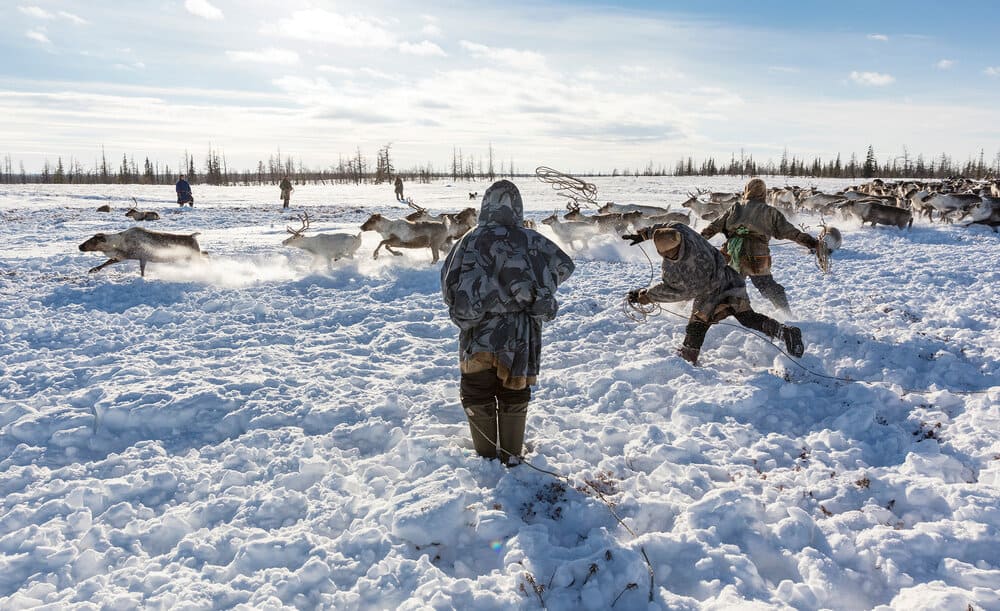
Living in remote wilderness necessitates such resourcefulness, but it’s a rarity in today’s hyper-specialized, technology-driven world to find people with so much broad-based, practical knowledge and skill. Something will have gone out of us as a people if we ever let our ability to sustain ourselves off the land disappear. It’s sobering to consider how much of this has already been lost. Once again, I’m humbled to be here and grateful that these Nenets are keeping me alive.
Brigade 20 has stayed put for the first three days of our visit, which I gather is to give us time to acclimate. But on day four, we break camp. The first experience of the move is startling and exciting, like a carnival, but it’s also as complex as a military maneuver. Imagine packing your family’s home onto 13 refrigerator-size plywood sledges. Each item has an order in which it’s packed and a precise spot where it’s stowed, down to the way the wash pail fits inside the legs of Rosa’s stool. The sections of our chum’s walls, four in all, weigh 75 to 100 pounds each and must be folded carefully to prevent icing. Zhenya, Jen and I help Alexey with the task; normally, he and Rosa manage fine on their own. Even with a predawn start, the packing isn’t finished until midmorning. Afterward, a few herders drive the working bulls — which are kept separate from the main herd — into a makeshift pen. Each sledge requires around four reindeer to pull it, and by the time the animals are selected and harnessed, another two hours have passed.
We travel six miles through snowy open country broken by skeletal trees. Four hours after setting out, the brigade reconstructs the camp in a virtual rewind of the morning’s packing, and the silvery cape of dusk has already settled before we’ve erected the chum. Inside, I sag from fatigue. I am weary and looking forward to bedtime; I’m sleeping better here on my back sandwiched between Zhenya and Jen than on my expensive bed back home. But the process of moving has been so slow and convoluted that it’s difficult not to be overcome by a sense of futility. I can’t imagine having to repeat the laborious process three more times before the end of our trip, yet the Nenets pack and unpack their lives almost every day. When I ask Alexey how he feels about this, he tells me he’s neither happy nor sad — it’s just the way life is. “I sometimes think about doing other things, but what would I do? If we moved to the town, it would be difficult without the tundra.”
It’s easy to romanticize the Nenets’ life, the simplicity of wilderness and the incredible knowledge and ability it takes to subsist in such a trying place. Yet life in Arctic Siberia is sheer, exhausting toil. “This is the best time of year,” Alexey says over tea one afternoon. He’s talking about these transitional days from winter, when temperatures can still reach -40°F and below but at least there’s more than a few hours of daily light. “In spring, the animals don’t stay together as much. In summer, it’s hard to move without the snow. In fall, there’s mud and lakes to cross. In winter, everything almost stops. Life here goes from difficult to more difficult.” He tells me he’d like to move to Yar-Sale and find an easier life, but he has no skills that would allow it.
“It’s easy to romanticize the Nenets’ life, the simplicity of wilderness and the incredible knowledge and ability it takes to subsist in such a trying place. Yet life in Arctic Siberia is sheer, exhausting toil.”
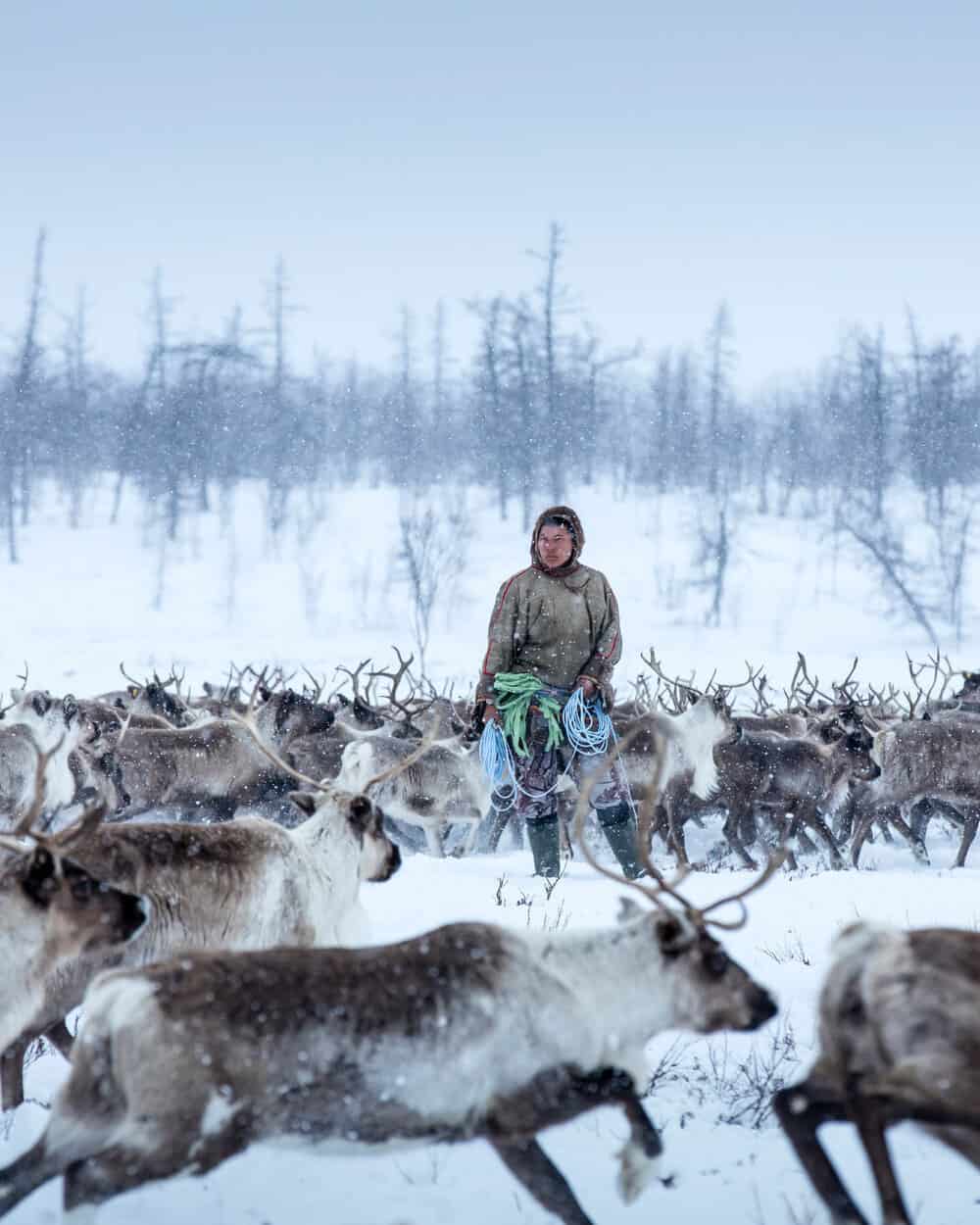
For all the hardships of their nomadic lifestyle, the Nenets are better educated and connected than I would have thought. Russian law says that every citizen must attend school, so starting at age six, the children are sent to the towns. Few make it through high school, however, and instead return to help their families with work. But they come back with good Russian skills, modern tools such as snowmobiles and chainsaws, and increasingly, computers and cell phones. There is a baffling incongruity to watching people who can turn reindeer bone into tack and trees into tools simultaneously watch DVDs on their computers.
I came here hoping to escape the churn and demands of modern life at home. Meanwhile, the Nenets daydream of city life as an existence with less hardship. The human experience is one of striving and yearning. We can’t run away from modernity; the knowledge and technology of life today is inescapable and, despite the pitfalls, precious. But the ability to exist and subsist on your own in nature — the old ways — is invaluable. I’m not running away from the future. I’m chasing what it means to be human, albeit in a different time.
One night, Alexey and Rosa load up a special treat for us: a BBC documentary about the Nenets. They coo with pride at scenes of another brigade erecting their chums and loading their caravans, and they tsk and laugh when one of the men repeatedly misses capturing an animal with his lasso. I can’t help but think that watching the Nenets watch themselves signals the end of an era.
Though the crossing of the Gulf of Ob is to be the trip’s crescendo, the most jarring moment comes days earlier, when we witness the slaughter of a reindeer. Most of the animals killed each year are sold to a meat-processing plant in Yar-Sale. But the brigade takes a share for meat and hides. When I ask Alexey how many reindeer his family consumes each year, he says, “What we need.” It’s a simple rule to live by.
In the mid-morning, after tea, a few of us are chopping wood and fixing sleds outside the chums when two men from the brigade, Pasha and Vassily, drive the working bulls into camp. As the rest of the men encircle the animals with snowmobiles, the two herders split the charge so that a stream of reindeer passes between them. They raise their lassos and cast them around the neck of the same animal from opposite sides. Nenets kill reindeer by strangulation, which preserves the pelt and prevents blood from spilling. The animal spasms and gasps for almost 10 minutes.
When the reindeer finally goes limp, the men clean it, then slash the jugular from within so blood pools into the body cavity. Vassily sprinkles salt into the viscous garnet soup, then dips a chipped ceramic coffee mug and drinks. The brigade circles like carrion, passing around the mug of blood and knifing gobbets of flesh into their mouths. The butchery is hard to watch, but in the context of a diet bereft of nutrients, it makes sense. “You feel the life rushing into you when you eat the reindeer,” Rosa says, offering me a piece of dripping meat. Gnawing on raw venison in the biting cold of a Siberian winter will never top my culinary bucket list. But in a day when globalization is turning the planet as homogenous as suburban America, it’s refreshing to have to confront and experience a place on its own terms.
If travel is meant to challenge and transport, life among the Nenets is the essence of what I chase when I go away. The Siberian tundra is one of the most stark and stunning landscapes still left on the planet; it will also kill you with its bleak desolation. Its people are some of the most self-sufficient and skilled outdoorsmen anywhere, able to live off the land in the most inhospitable of settings, and yet they yearn for the modern conveniences of power tools and connectivity that will simultaneously alleviate their toil and dull their knowledge and skills. The simplicity of existence here feels calming and restorative, yet if it was the only option, the continual grind every day, it would probably be as numbing as office work. Life with the Nenets, just like the chaos of my busy, modern existence back home, is full of contradictions.
On the morning we’re to traverse the frozen gulf, everyone exhales in relief when dawn rises windless, sharp, and bright. The 30-mile crossing is three times the distance Nenets usually cover in a day, and on the ice there’s no forage and no escape. Six years ago, a blizzard struck during the migration, and the strafing winds and thick, gauzy snow pinned Alexey, Vassily, and a few others for 48 hours with nothing but their malitsas for cover. Almost a quarter of the herd perished from exposure and starvation. There will be no such calamity today.
“The butchery is hard to watch, but in the context of a diet that is bereft of nutrients, it makes sense. “You feel the life rushing into you when you eat the reindeer,” Rosa says offering me a piece of dripping meat.”
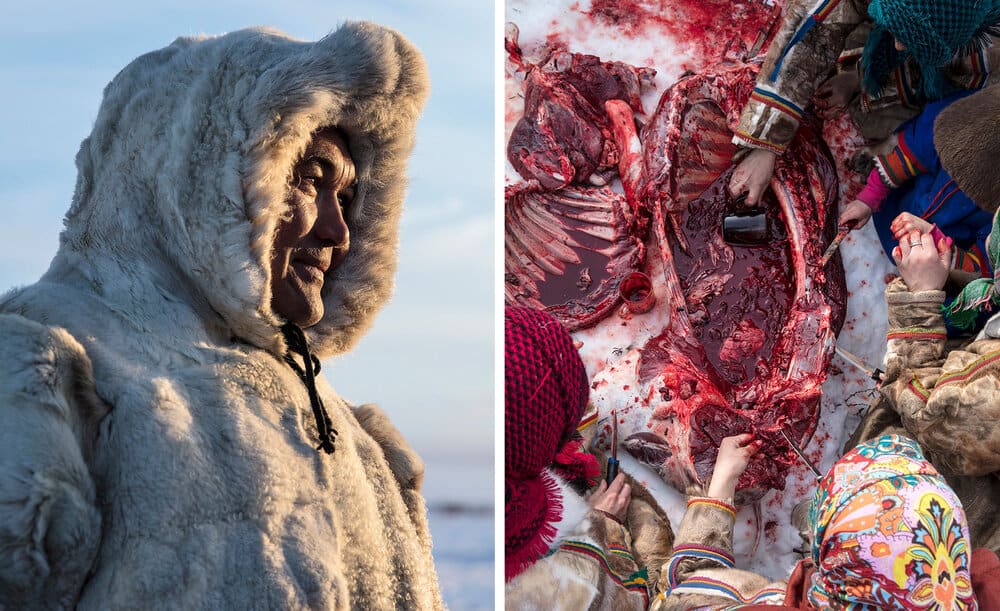
Brigade 20 slides down the riverbank and onto the Gulf of Ob like a scene from the Book of Exodus. A column of fur-clad nomads, overloaded sledges, and steaming reindeer stretches over a mile toward the horizon. The ferocious emptiness of the open ice is calming. It’s a frozen desert, with fossil-like shapes cut by the wind into drifts and dunes that stretch out and merge seamlessly into the vast sky. On the back of a sledge driven by a 19-year-old herder named Jarik, I glide toward the shelter of the far-off shore at a pace I could almost walk. The only sounds are the hiss of the wooden runners through the snow and the click of the reindeer hooves like rain slapping a tin roof. For hours, we sit in silence and my mind moves as methodically as the sledge from one uninterrupted thought to another. There’s no churn of silly details. On the tundra, every moment and day feels like one long, smooth exhalation. That won’t last forever; life here is changing. But, at least for now, I can breathe.